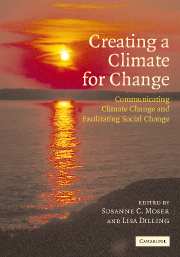Book contents
- Frontmatter
- Contents
- Preface
- Foreword
- List of contributors
- List of tables
- List of figures
- List of text boxes
- Introduction
- Part I Communicating climate change
- Part II Facilitating social change
- 15 Stuck in the slow lane of behavior change? A not-so-superhuman perspective on getting out of our cars
- 16 Consumption behavior and narratives about the good life
- 17 Educating for “intelligent environmental action” in an age of global warming
- 18 Education for global responsibility
- 19 Changing the world one household at a time: Portland's 30-day program to lose 5,000 pounds
- 20 Changing organizational ethics and practices toward climate and environment
- 21 Change in the marketplace: business leadership and communication
- 22 The market as messenger: sending the right signals
- 23 Making it easy: establishing energy efficiency and renewable energy as routine best practice
- 24 Forming networks, enabling leaders, financing action: the Cities for Climate Protection™ campaign
- 25 Ending the piecemeal approach: Santa Monica's comprehensive plan for sustainability
- 26 States leading the way on climate change action: the view from the Northeast
- 27 West Coast Governors' Global Warming Initiative: using regional partnerships to coordinate climate action
- 28 Building social movements
- 29 Climate litigation: shaping public policy and stimulating debate
- 30 The moral and political challenges of climate change
- Part III Creating a climate for change
- About the authors
- Index
- References
28 - Building social movements
Published online by Cambridge University Press: 20 August 2009
- Frontmatter
- Contents
- Preface
- Foreword
- List of contributors
- List of tables
- List of figures
- List of text boxes
- Introduction
- Part I Communicating climate change
- Part II Facilitating social change
- 15 Stuck in the slow lane of behavior change? A not-so-superhuman perspective on getting out of our cars
- 16 Consumption behavior and narratives about the good life
- 17 Educating for “intelligent environmental action” in an age of global warming
- 18 Education for global responsibility
- 19 Changing the world one household at a time: Portland's 30-day program to lose 5,000 pounds
- 20 Changing organizational ethics and practices toward climate and environment
- 21 Change in the marketplace: business leadership and communication
- 22 The market as messenger: sending the right signals
- 23 Making it easy: establishing energy efficiency and renewable energy as routine best practice
- 24 Forming networks, enabling leaders, financing action: the Cities for Climate Protection™ campaign
- 25 Ending the piecemeal approach: Santa Monica's comprehensive plan for sustainability
- 26 States leading the way on climate change action: the view from the Northeast
- 27 West Coast Governors' Global Warming Initiative: using regional partnerships to coordinate climate action
- 28 Building social movements
- 29 Climate litigation: shaping public policy and stimulating debate
- 30 The moral and political challenges of climate change
- Part III Creating a climate for change
- About the authors
- Index
- References
Summary
Maybe a president or Congressional leader will, upon reading a report by the American Academy of Arts and Sciences or hearing a plea from the leader of another country or even glancing at this book, become convinced of the need to take substantial action to address the dangers of global warming. Once convinced, this leader would build broad political coalitions with other political figures based on reasoned appreciation of a real environmental problem, and devise a comprehensive set of policy reforms to reduce America's key role in promoting global warming. Within a few years, the United States would develop and implement a range of policies to reduce the concentration of CO2 in the atmosphere, including dedicated taxes, regulatory reforms, and large-scale initiatives in renewable energy and energy conservation.
This could happen, but that's not the way major changes in American history have taken place before. Reasoned discourse needs a push. Elected officials, even presidents, are subject to an ever-expanding range of pressures and constraints, making substantial policy reform in any area exceedingly difficult. Further, the American Constitution established a governmental structure built to produce stability rather than innovation, solidity rather than responsiveness – in effect, a Humvee rather than a hybrid of government. But substantial, if sometimes unwelcome, innovations in policy have taken place in America, including (among others) the institution of a federal social safety net for the elderly in the 1930s, the establishment of a permanent and globally engaged military establishment in the 1940s, federal intervention in the cause of civil rights and women's rights in the 1950s and 1960s, and a broad retrenchment in government support for the less fortunate, commenced in the 1970s.
- Type
- Chapter
- Information
- Creating a Climate for ChangeCommunicating Climate Change and Facilitating Social Change, pp. 451 - 461Publisher: Cambridge University PressPrint publication year: 2007
References
- 5
- Cited by



